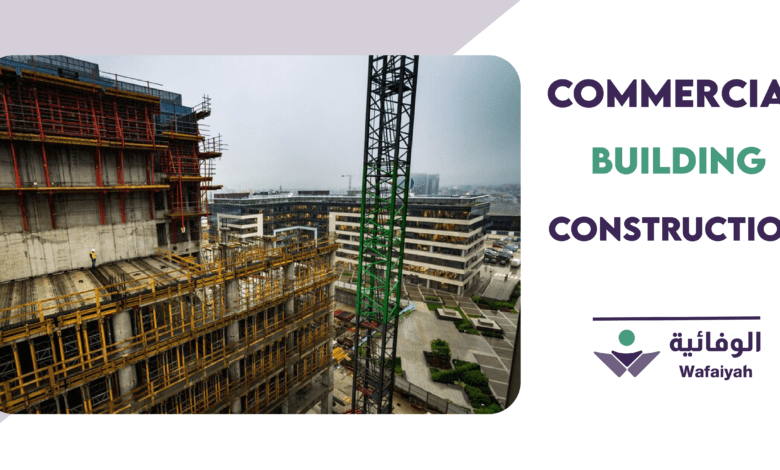Commercial Building Construction in Saudi Arabia: Trends, Challenges, and Opportunities

Introduction:
The Kingdom of Saudi Arabia stands as a beacon of economic development in the Middle East, with its robust construction sector playing a pivotal role. Amidst its diverse construction landscape, the realm of commercial building construction holds significant prominence. In this discourse, we delve into the trends, challenges, and opportunities shaping the commercial building construction sector in Saudi Arabia.
Trends:
Green Building Initiatives: Saudi Arabia is increasingly embracing sustainable practices in construction. The implementation of green building standards, such as LEED (Leadership in Energy and Environmental Design) and Estidama, reflects a growing commitment to environmental conservation and energy efficiency.
Mixed-Use Developments: Urbanization and population growth are driving demand for integrated spaces that combine residential, commercial, and recreational elements. Mixed-use developments are gaining traction, catering to the evolving lifestyle preferences of Saudis.
Technological Integration: The adoption of Building Information Modeling (BIM), drones, and other advanced technologies is revolutionizing the construction process. These innovations enhance efficiency, reduce costs, and improve safety across commercial building projects.
High-Rise Construction: As urban centers expand vertically to optimize land use, high-rise buildings are becoming increasingly prevalent. Iconic skyscrapers, such as the Jeddah Tower, exemplify Saudi Arabia’s ambition to redefine its skyline and establish architectural landmarks.
Smart Buildings: The concept of smart buildings, equipped with IoT (Internet of Things) devices and automation systems, is gaining momentum. These intelligent structures offer enhanced occupant comfort, operational efficiency, and sustainability.

Challenges:
Regulatory Complexity: Navigating Saudi Arabia’s regulatory framework, characterized by intricate permitting processes and stringent building codes, poses a challenge for developers. Streamlining bureaucracy is imperative to expedite project timelines and mitigate delays.
Skilled Labor Shortage: Despite efforts to localize the workforce, the construction industry grapples with a shortage of skilled professionals. Addressing this gap requires comprehensive vocational training programs and initiatives to attract talent to the sector.
Supply Chain Disruptions: Vulnerabilities in the global supply chain, exacerbated by geopolitical tensions and pandemics, can disrupt the procurement of construction materials. Diversifying sourcing channels and investing in domestic manufacturing capacities can enhance resilience.
Sustainability Imperatives: While sustainability is gaining traction, integrating green technologies and materials into commercial projects entails initial investment costs. Balancing environmental stewardship with economic viability remains a persistent challenge for stakeholders.
Infrastructure Deficiencies: Inadequate infrastructure, particularly in remote regions, hampers the development of commercial projects. Improving accessibility through investments in transportation networks and utilities is essential to unlock growth opportunities.
Opportunities:
Infrastructure Development: Saudi Arabia’s ambitious Vision 2030 agenda prioritizes infrastructure development as a catalyst for economic diversification. Investment opportunities abound in projects encompassing transportation hubs, healthcare facilities, and educational institutions.
Public-Private Partnerships (PPP): Collaborative ventures between the government and private sector present lucrative prospects for commercial developers. PPP frameworks facilitate risk-sharing, enhance efficiency, and foster innovation in infrastructure projects.
Tourism and Hospitality: With a burgeoning tourism sector, fueled by initiatives like the Red Sea Project and NEOM, there is a surge in demand for hospitality infrastructure. Investing in hotels, resorts, and entertainment complexes offers promising returns amidst growing visitor influx.
E-commerce Infrastructure: The proliferation of e-commerce is reshaping retail dynamics, necessitating the development of logistics centers and distribution facilities. Establishing state-of-the-art warehouses and fulfillment centers aligns with the evolving retail landscape.
Smart Cities Initiatives: Saudi Arabia’s ambition to develop smart cities, exemplified by projects like NEOM and Riyadh’s Digital City, presents unparalleled opportunities for technology-driven urban development. Collaboration with global tech firms can drive innovation in smart infrastructure solutions.
Conclusion:
Commercial building construction in Saudi Arabia is poised at the nexus of innovation, sustainability, and economic transformation. While confronting multifaceted challenges, stakeholders are primed to capitalize on emerging trends and seize lucrative opportunities. By fostering collaboration, embracing technology, and prioritizing sustainability, the Kingdom can realize its vision of a vibrant and resilient built environment that fuels prosperity for generations to come.



